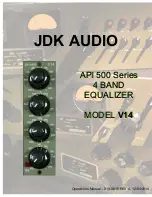
position, signal is allowed to pass from the input to the output
with no equalization. The green power LED will glow red when
Bypass is engaged. In its “out” position, the EQ is active. Use the
Bypass switch when setting the Tube EQ’s input and output levels
to achieve unity (no boost or cut) gain. Unity gain is achieved
when the active level is the same as the bypassed level.
G
Ga
aiin
n C
Co
on
nttrro
oll
The Gain control sets the amount of input gain to the Tube EQ.
Turn the control clockwise to increase gain and counterclockwise
to decrease it. To maximize your signal to noise ratio, it is impor-
tant to start with a unity gain setting (meaning that the level into
the Tube EQ is the same as the level out of the Tube EQ). With
the output level at its “0” position, adjust the input gain until the
level is the same when the Tube EQ is bypassed and active.
C
Clliip
p IIn
nd
diicca
atto
orr
The Clip indicator will illuminate just before any gain stage of
the Tube EQ reaches audible distortion. Typically this will indicate
clipping at the input stage (which is corrected by turning down
the input gain control). However, it will also indicate any distor-
tion caused by excessive EQ’ing. In other words, if turning down
the input gain control doesn’t make the clip indicator turn off,
check the frequency bands for excessive boost.
O
Ou
uttp
pu
utt LLeevveell C
Co
on
nttrro
oll
The Output Level control sets the output level of the Tube EQ.
The output level is a gain stage intended to compensate for a
boost or cut in level from the applied EQ. When the control is
fully counterclockwise, there is no output. Turning the control
clockwise increases the level of the output to a maximum of
+10dB of gain. To achieve unity gain (meaning the level into the
Tube EQ is the same as the level out of the Tube EQ) the output
level should be adjusted
after setting the EQ bands so that the
bypass level is the same as the active level. If you are boosting
EQ bands (adding gain), you’ll have to turn down the output
9
Summary of Contents for DUAL TUBE EQ
Page 1: ...TUBE EQ PROFESSIONAL TUBE PARAMETRIC EQUALIZER USER S GUIDE ...
Page 20: ......






































